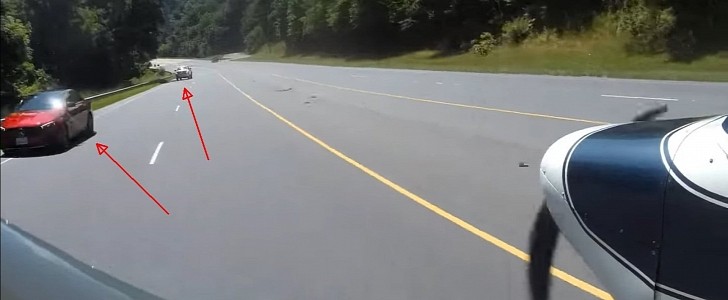A driverless car needs to be able to handle all driving situations, no matter how unthinkable they might be. The video of a plane landing on a live highway shows the kind of encounter a self-driving car should deal with.
Automated driving systems are promised to be able to replace human drivers soon, enhancing safety and relieving people from the boredom of keeping their eyes on the road. Nevertheless, the sheer complexity of driving situations means self-driving will probably never be as good as humans. Most self-driving systems, including Tesla, rely on machine learning, which means the system must be trained in countless real-world situations. It can then reliably recognize such a situation and react accordingly.
This is why Tesla is probably further ahead in the self-driving game than any other company. The EV maker has a massive fleet of automated-driving-capable vehicles with billions of driven miles under the belt. That’s a lot of data for Tesla’s computers to chew and learn from. But no matter how much data gathering happens, there are still weird situations that nobody thought would happen.
The video of a plane performing an emergency landing on a live highway made the news this weekend. It was one of those a-ha moments that prompted Tesla fan Whole Mars Catalog to tweet, “A driverless car needs to be able to handle all of this. It’s the most insanely difficult software problem ever.” And this is true even though most drivers would never encounter such a situation in their entire lives.
Looking at the video, you see how regular drivers spot the plane coming in for landing in their lane and making adjustments to their path. At some point in the video, the plane goes the wrong way on the highway, forcing a driver to pull over and wait. Everything goes smoothly, and nothing bad happens, even though no driver is ever trained for an incoming plane landing in their lane.
And that’s precisely where software is lacking, making quick judgments based on situations even before they unfold. The drivers saw an object coming from the sky and predicted it could not take the sharp turn in the road, hence landing in their way. They took precautionary action to avoid a collision, and everything went buttery-smooth.
Would a self-driving car spot a plane? Most probably, if it has sensors in place to detect flying objects (which they don’t, for obvious reasons). But predicting a plane’s trajectory would be much more complicated in software, while humans can figure it out in a fraction of a second even without a genius IQ. What do you think about self-driving being ready for prime time “next year?” We’d love to read your opinion in the comments section below.
This is why Tesla is probably further ahead in the self-driving game than any other company. The EV maker has a massive fleet of automated-driving-capable vehicles with billions of driven miles under the belt. That’s a lot of data for Tesla’s computers to chew and learn from. But no matter how much data gathering happens, there are still weird situations that nobody thought would happen.
The video of a plane performing an emergency landing on a live highway made the news this weekend. It was one of those a-ha moments that prompted Tesla fan Whole Mars Catalog to tweet, “A driverless car needs to be able to handle all of this. It’s the most insanely difficult software problem ever.” And this is true even though most drivers would never encounter such a situation in their entire lives.
Looking at the video, you see how regular drivers spot the plane coming in for landing in their lane and making adjustments to their path. At some point in the video, the plane goes the wrong way on the highway, forcing a driver to pull over and wait. Everything goes smoothly, and nothing bad happens, even though no driver is ever trained for an incoming plane landing in their lane.
And that’s precisely where software is lacking, making quick judgments based on situations even before they unfold. The drivers saw an object coming from the sky and predicted it could not take the sharp turn in the road, hence landing in their way. They took precautionary action to avoid a collision, and everything went buttery-smooth.
Would a self-driving car spot a plane? Most probably, if it has sensors in place to detect flying objects (which they don’t, for obvious reasons). But predicting a plane’s trajectory would be much more complicated in software, while humans can figure it out in a fraction of a second even without a genius IQ. What do you think about self-driving being ready for prime time “next year?” We’d love to read your opinion in the comments section below.
A driverless car needs to be able to handle all of this @elonmusk https://t.co/FCJSTemUYn
— Whole Mars Catalog (@WholeMarsBlog) July 11, 2022






